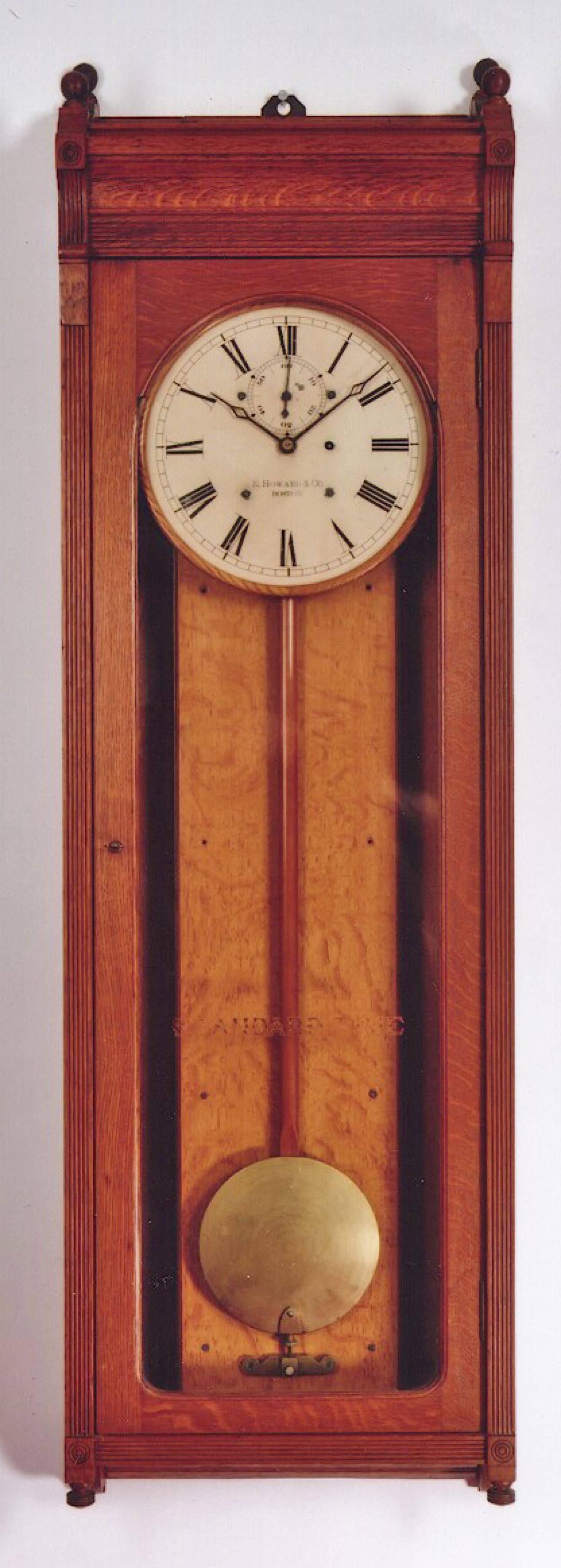E. Howard & Co., Boston, MA. Model No. 89. Wall Regulator. 212062.
9/2023-81
212062 E. Howard Clock Company Model No. 89.
The construction of this case oak is designed to compensate for expansion and contraction due to changes in humidity and temperature. This very model was specially designed for railroad use.
Ten examples were tested in August of 1889. The regulators tested were furnished to the Buffalo, B. & S. W., the Niagara Falls division of the New York, Lake Erie, and Western Railroads. These ten clocks had an average variation from the mean of only 8.9 seconds over the period of one month time. The greatest variation was measured at 24 seconds. Other clocks performed even better. A clock located in the Wabash Station in Moberly, Missouri, ran 18 days right on time and 30 days with a three-second variation. A clock at the Union Depot in Cleveland, Ohio, ran 16 weeks with an extreme variation of only 3 seconds in any one week. As a result, it has developed a reputation for being a very sound timekeeper.
This is an excellent example that features a classic finish. The case is constructed in oak and displays a number of decorative details, including the reeded moldings and turned finials. The large door on the front of the case is fitted with a large piece of clear glass. This glass retains the original advertisement of “STANDARD TIME,” which is written across the middle in stylized lettering. Through this door, one can view the painted dial, which the Maker signs in block lettering. The painted zinc dial measures 12 inches in diameter and is original to this clock. It features Roman hour numerals and a subsidiary seconds dial. This dial is trimmed with an oak bezel or ring and mounts directly to the movement via four posts. The pendulum rod is made of seasoned cherry and, at one time, was gilded. This rod supports the large brass-covered bob that is filled with zinc for compensation. The brass is decorated with an engine-turned design. The weight-driven movement is very good quality. It is framed with two large brass rectangular-shaped plates. The front plate is die-stamped by the Maker in the upper left-hand corner. The movement, photographed before servicing, is designed to run for eight days on a single wind. It features a Graham Dead Beat Escapement and maintaining power. The movement is wound with a crank key. A Geneva Stop prevents one from overwinding this clock. The weight falls directly below the movement. It is hidden from view by the wooden channel constructed inside the case.
5*1891
This is a large and impressive-looking clock. The case measures 65 inches long by 19 inches wide and 8 inches deep. The interior of the case is die stamped with the manufacture date of “5 * 1891” or May 1891.
This clock is $6,850.
Inventory number 212062.
The E. Howard & Company succeeded the Howard & Davis firm in 1857. The Howard & Davis firm was comprised of Edward Howard and David Porter Davis and was established in 1842 in Roxbury, Massachusetts. Both men had just completed their clock apprenticeship under the guidance of Aaron Willard Jr in Boston. The Howard & Davis firm made high-grade clocks, precision balances, sewing machines, fire engines, and watches. After the dissolution of Howard & Davis, Edward Howard became Boston's leading manufacturer of weight-driven residential and commercial clocks. The firm also made a large number of tower clocks and watchman and salve clock systems. These sold well in the last quarter of the 1800s.
It has been said that the E. Howard Clock company never made an inexpensive clock, and everything they made was of very good quality. As a result, Howard clocks have become very collectible and are prized by their owners. Today, the E. Howard name enjoys outstanding name recognition.
For a more in-depth reading of Edward Howard and his various businesses, please read "Willard's Patent Time Pieces," written by Paul Foley.












